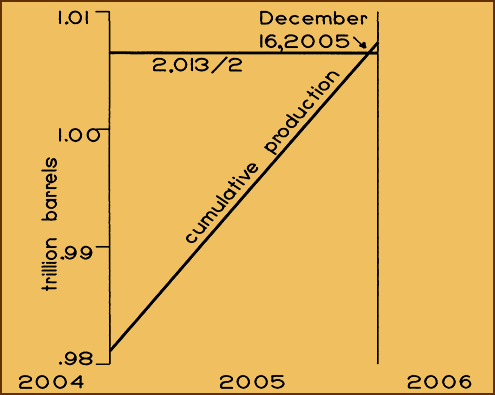|
Join us as we watch the crisis unfolding Kenneth S. Deffeyes February 11, 2006 Professor Ken Deffeyes is a geologist and professor emeritus at Princeton. He is considered to be one of the leading experts on the question of "peak oil" and is the author of two books on the subject, Hubbert's Peak: the Impending World Oil Shortage (2001) and Beyond Oil: The View from Hubbert's Peak (2005) Visit his website, Beyond Oil: The View From Hubbert's Peak at http://www.princeton.edu/hubbert/. In the January 2004 Current Events on my website, I predicted that world oil production would peak on Thanksgiving Day, November 24, 2005. In hindsight, that prediction was in error by three weeks. An update using the 2005 data shows that we passed the peak on December 16, 2005. "A decent respect to the opinions of mankind requires" that I present an update on the data sources and the interpretation.
There are some interesting additional bits in the end-of-year statistics. Compared to 2004, world oil production was up 0.8 percent in 2005, nowhere near enough to compensate for a demand rise of roughly 3 percent. The high prices did not bring much additional oil out of the ground. Most oil-producing countries are in decline. The rise in production was largely from Saudi Arabia, Russia, and Angola. The Saudi production for 2005 was 9.155 million barrels per day. On March 6, 2003 Saudi Aramco and the government of Saudi Arabia announced by way of the Dow Jones newswire that they were maxed out at 9.2 barrels per day. In retrospect, that statement seems to be accurate. Further details are in Matthew Simmons' book Twilight in the Desert. Could some new discovery come along and reverse the global oil decline? The world oil industry is a huge system: Annual production worth 1.7 trillion dollars. I don't see anything on the horizon large enough to turn it around. So what are the policy implications? Numerous critics are claiming that the present world economic situation is a house of cards: built on trade deficits, housing price bubbles, and barely-adequate natural gas supplies. Pulling any one card out from the bottom of the pile might collapse the whole structure.
Since we have passed the peak without initiating major corrective measures, we now have to rely primarily on methods that we have already engineered. Long-term research and development projects, no matter how noble their objectives, have to take a back seat while we deal with the short-term problems. Long-term examples in the proposed 2007 US budget (Feb. 9, 2006 New York Times page A-18) include a 65 percent increase in the programs to produce ethanol from corn, a 25.8 percent increase for developing hydrogen fuel cell cars, and a 78.5 percent increase in spending on solar energy research. The Times reports that solar energy today supplies one percent of US electricity; the hope is to double that to 2 percent by the year 2025. By 2025, we're going to be back in the Stone Age.
Ethanol, fuel cells, and solar cells are not the only shimmering dreams. Methane hydrates, oil shale, and the Yucca Mountain radioactive waste depository would be better off forgotten. There are plenty of solid opportunities. Energy conservation is by far the most important. Initiatives that are already engineered and ready to go are biodiesel from palm oil, coal gasification (for both gaseous and liquid fuels), high-efficiency diesel automobiles, and revamping our food supply. Every little bit helps, but even if wind energy continues its success it will still be a little bit. That's it. I can now refer to the world oil peak in the past tense. My career as a prophet is over. I'm now an historian. © 2001—2005 - K. Deffeyes All Rights Reserved. Reprinted with permission. |
